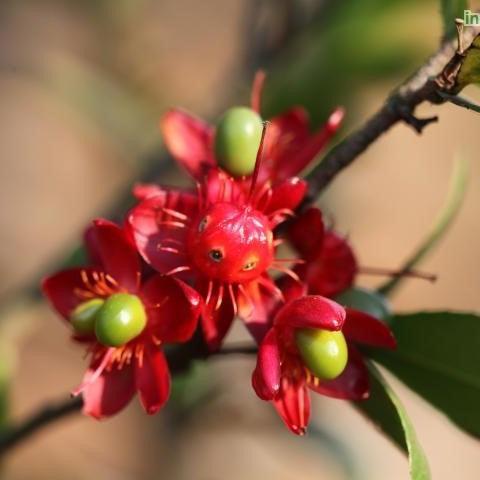Information about Ochna serrulata:
Ochna serrulata, also known as the Mickey Mouse plant or bird's eye bush, is a small evergreen shrub that belongs to the Ochnaceae family. It is native to southern Africa and is grown in many parts of the world as an ornamental plant. The plant is known for its attractive flowers and fruit, which are dark blue to black in color and resemble Mickey Mouse ears.
Planting Ochna serrulata:
Ochna serrulata can be planted in the ground or in a container. If planting in the ground, choose a well-draining location with full sun to partial shade. The soil should be moist and rich in organic matter. If planting in a container, use a well-draining potting mix and make sure the container has drainage holes.
Growing Ochna serrulata:
Ochna serrulata can grow up to 6 feet tall and wide, but it can be pruned to maintain a smaller size. The plant prefers a warm, humid climate and is hardy in USDA zones 9 to 11. Water the plant regularly, especially during dry periods, but make sure not to overwater it. Fertilize the plant with a balanced fertilizer every two to three months during the growing season.
Care for Ochna serrulata:
Ochna serrulata is a relatively low-maintenance plant, but it does require some care to thrive. Prune the plant in the spring to remove any dead or damaged branches and to maintain its shape. The plant may also benefit from a light pruning after it has finished flowering to encourage bushier growth. Watch out for pests such as aphids, scale insects, and spider mites, and treat them with insecticidal soap or neem oil if necessary.
Benefits of Ochna serrulata:
Ochna serrulata has several benefits, including:
- Ornamental value: The plant is popular as an ornamental plant due to its attractive flowers and fruit.
- Medicinal properties: The plant has been traditionally used in African medicine to treat various ailments, including stomach problems, fever, and respiratory infections.
- Biodiversity: Ochna serrulata is an important plant for pollinators, providing nectar and pollen for bees and butterflies.
- Cultural significance: The plant is considered a symbol of good luck and is often used in traditional African and Chinese celebrations.




